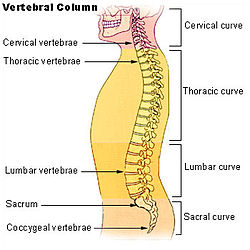
The coccyx
| |

The coccyx is the final bone in the vertebral column that surrounds the spinal cord.
| |
ta]
|
The coccyx (pl: coccyges), which is commonly referred to as the tailbone, is the final segment of the vertebral column in all apes, and analogous structures in certain other mammals such as horses. In tailless primates(e.g. humans and other great apes) since Nacholapithecus (a Miocenehominoid),[1][2] the coccyx is the remnant of a vestigial tail. In animals with bony tails, it is known as tailhead or dock, in bird anatomy as tailfan. It comprises three to five separate or fused coccygeal vertebrae below the sacrum, attached to the sacrum by a fibrocartilaginous joint, the sacrococcygeal symphysis, which permits limited movement between the sacrum and the coccyx.
Understandably people in general feel a repugnance to the idea that an ape was my ancestor.” I find this humiliating fact hard hard to accept myself. However the distress such a thought may cause you is nothing compared to the distress caused by the fear of damnation in Hell
if you don't believe in the word of God.
Understandably people in general feel a repugnance to the idea that an ape was my ancestor.” I find this humiliating fact hard hard to accept myself. However the distress such a thought may cause you is nothing compared to the distress caused by the fear of damnation in Hell
if you don't believe in the word of God.
So we have to respect Darwin’s indelicate announcement in The Descent of Man (1871), that humans had “descended from a hairy quadruped, furnished with a tail and pointed ears,” indeed attracted considerable attention.
And some conservative Christians did express abhorrence at the prospect of relinquishing an honored position at the head of created beings only to be herded together “with four-footed beasts and creeping things,” over which man had formerly held dominion.
Darwinism, complained one contemptuous critic, “tears the crown from our heads; and reveals the degrading fact that man in his best estate— even Mr. Darwin—is but a civilized, dressed up, educated monkey, who has lost his tail.” There is no reason to believe, however, that such die-hard creationists ever took human evolution seriously enough to be more than rhetorically distressed.
No comments:
Post a Comment